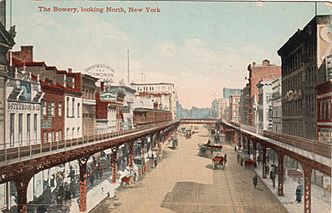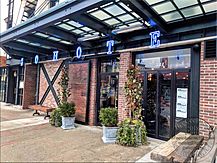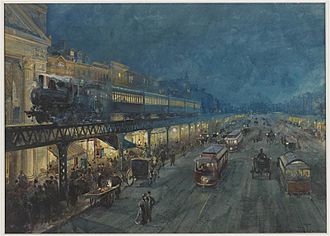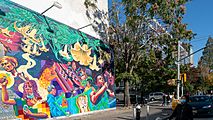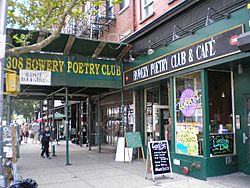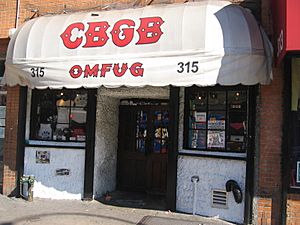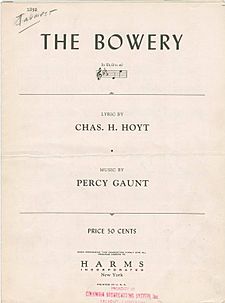Bowery facts for kids
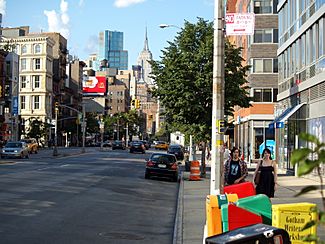
Looking north from Houston Street
|
|
| Former name(s) | Bowery Lane (prior to 1807) |
|---|---|
| Length | 1.6 km (1.0 mi) |
| South end | Chatham Square |
| North end | East 4th Street (continues as Cooper Square) |
The Bowery (/ˈbaʊəri/) is a street and neighborhood in Lower Manhattan in New York City, United States. The street runs from Chatham Square at Park Row, Worth Street, and Mott Street in the south to Cooper Square at 4th Street in the north. The eponymous neighborhood runs roughly from the Bowery east to Allen Street and First Avenue, and from Canal Street north to Cooper Square/East Fourth Street. The neighborhood roughly overlaps with Little Australia. To the south is Chinatown, to the east are the Lower East Side and the East Village, and to the west are Little Italy and NoHo. It has historically been considered a part of the Lower East Side of Manhattan.
In the 17th century, the road branched off Broadway north of Fort Amsterdam at the tip of Manhattan to the homestead of Peter Stuyvesant, director-general of New Netherland. The street was known as Bowery Lane prior to 1807. "Bowery" is an anglicization of the Dutch bouwerie, derived from an antiquated Dutch word for "farm": In the 17th century the area contained many large farms.
The New York City Subway's Bowery station, serving the BMT Nassau Street Line (J and Z train), is located close to the Bowery's intersection with Delancey and Kenmare Streets. There is a tunnel under the Bowery intended for use by a never-built subway extension. The M103 bus runs on the entire Bowery.
History
Colonial and Federal periods
The Bowery is the oldest thoroughfare on Manhattan Island, preceding European intervention as a Lenape footpath, which spanned roughly the entire length of the island, from north to south. When the Dutch settled Manhattan island, they named the path Bouwerij road—"bouwerij" being an old Dutch word for "farm"—because it connected farmlands and estates on the outskirts to the heart of the city in today's Wall Street/Battery Park area.
In 1654, the Bowery’s first residents settled in the area of Chatham Square; ten freed slaves and their wives set up cabins and a cattle farm there.
Petrus Stuyvesant, the last Dutch Governor of New Amsterdam before the English took control, retired to his Bowery farm in 1667. After his death in 1672, he was buried in his private chapel. His mansion burned down in 1778 and his great-grandson sold the remaining chapel and graveyard, now the site of the Episcopal church of St. Mark's Church in-the-Bowery.
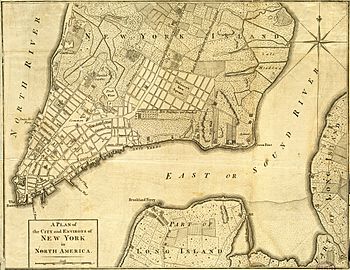
By 1766, when John Montresor made his detailed plan of New York, "Bowry Lane", which took a more north-tending track at the rope walk, was lined for the first few streets with buildings that formed a solid frontage, with market gardens behind them; when Lorenzo Da Ponte, the librettist for Mozart's Don Giovanni, The Marriage of Figaro, and Così fan tutte, immigrated to New York City in 1806, he briefly ran one of the shops along the Bowery, a fruit and vegetable store. In 1766, straight lanes led away at right angles to gentlemen's seats, mostly well back from the dusty "Road to Albany and Boston", as it was labeled on Montresor's map; Nicholas Bayard's was planted as an avenue of trees. James Delancey's grand house, flanked by matching outbuildings, stood behind a forecourt facing Bowery Lane; behind it was his parterre garden, ending in an exedra, clearly delineated on the map.
The Bull's Head Tavern was noted for George Washington's having stopped there for refreshment before riding down to the waterfront to witness the departure of British troops in 1783. Leading to the Post Road, the main route to Boston, the Bowery rivaled Broadway as a thoroughfare; as late as 1869, when it had gained the "reputation of cheap trade, without being disreputable" it was still "the second principal street of the city".
Rise of the area
As the population of New York City continued to grow, its northern boundary continue to move, and by the early 1800s the Bowery was no longer a farming area outside the city. The street gained in respectability and elegance, becoming a broad boulevard, as well-heeled and famous people moved their residences there, including Peter Cooper, the industrialist and philanthropist. The Bowery began to rival Fifth Avenue as an address.
When Lafayette Street was opened parallel to the Bowery in the 1820s, the Bowery Theatre was founded by rich families on the site of the Red Bull Tavern, which had been purchased by John Jacob Astor; it opened in 1826 and was the largest auditorium in North America at the time. Across the way the Bowery Amphitheatre was erected in 1833, specializing in the more populist entertainments of equestrian shows and circuses. From stylish beginnings, the tone of Bowery Theatre's offerings matched the slide in the social scale of the Bowery itself.
Revival
The vagrant population of the Bowery declined after the 1970s, in part because of the city's effort to disperse it. Since the 1990s the entire Lower East Side has been reviving. As of July 2005, gentrification is contributing to ongoing change along the Bowery. In particular, the number of high-rise condominiums is growing. In 2006, AvalonBay Communities opened its first luxury apartment complex on the Bowery, which included an upscale Whole Foods Market. Avalon Bowery Place was quickly followed with the development of Avalon Bowery Place II in 2007. That same year, the SANAA-designed facility for the New Museum of Contemporary Art opened between Stanton and Prince Street.
The new development has not come without a social cost. Michael Dominic's documentary Sunshine Hotel followed the lives of residents of one of the few remaining flophouses.
The Bowery from Houston to Delancey Street serves as New York's principal market for restaurant equipment, and from Delancey to Grand for lamps.
Areas
Upper and Lower Bowery
The upper Bowery refers to the portion of the Bowery above Houston Street; the lower Bowery refers to the portion below it.
Bowery Historic District
In October 2011, a Bowery Historic District was registered with the New York State Register of Historic Places and therefore was automatically nominated for listing on the National Register of Historic Places. A grassroots community organization named Bowery Alliance of Neighbors (BAN) in association with the community-based housing organization called the Two Bridges Neighborhood Council led the effort for creation of the historic district. The designation means that property owners will have financial incentives to restore rather than demolish old buildings on the Bowery. BAN was recognized for its preservation efforts with a Village Award from the Greenwich Village Society for Historic Preservation in 2013. The historic district runs from Chatham Square to Astor Place on both sides of the Bowery.
Little Saigon
New York's "Little Saigon", though not officially designated, exists on the Bowery between Grand Street and Hester Street. New York magazine claims that while this street blends in with neighboring Chinatown, the area is filled with Vietnamese restaurants.
Notable places
Amato Opera
This company, founded in 1948 by Tony Amato and his wife, Sally, found a permanent home at 319 Bowery next to the former CBGB and afforded many young singers the opportunity to hone their craft in full-length productions with a cut-down orchestration. The curtain fell on this well-established NYC opera forum on May 31, 2009, when Tony Amato retired.
Bank buildings
The Bowery Savings Bank was chartered in May 1834, when the Bowery was an upscale residential street, and grew with the rising prosperity of the city. Its 1893 headquarters building at 130 Bowery is an official New York City designated landmark, as is the 1920s domed Citizens Savings Bank.
Bowery Ballroom
The Bowery Ballroom is a music venue. The structure, at 6 Delancey Street, was built just before the Stock Market Crash of 1929. It stood vacant until the end of World War II, when it became a high-end retail store. The neighborhood subsequently went into decline again, and so did the caliber of businesses occupying the space. In 1997 it was converted into a music venue. It has a capacity of 550 people.
Directly in front of the venue's entrance is the Bowery station (J and Z train) of the New York City Subway.
The club serves as the namesake of at least one recording: Joan Baez's Bowery Songs album, recorded live at a concert at the Bowery Ballroom in November 2004.
Bowery Mural
The Bowery Mural is an outdoor exhibition space located on the corner of Houston Street and the Bowery, on a wall owned by Goldman Properties since 1984. Real estate developer Tony Goldman began the project with Jeffery Deitch and Deitch Projects in 2008. Goldman's goal was to use this wall to present the top contemporary artists from around the world, with an emphasis on artists who work on the streets. Seasonal murals have appeared on the wall curated and organized in collaboration with The Hole, NYC, an art gallery in SoHo run by former Deitch Projects directors Kathy Grayson and Meghan Coleman.
Bowery Poetry
Bowery Poetry is a performance space at Bowery and Bleecker Street. It was founded in 2001 as Bowery Poetry Club (BPC), and provided a home base for established and upcoming artists. It was founded by Bob Holman, owner of the building and former Nuyorican Poets Café Poetry Slam MC (1988–1996). The BPC featured regular shows by Amiri Baraka, Anne Waldman, Taylor Mead, Taylor Mali, along with open mic, gay poets, a weekly poetry slam, and an Emily Dickinson Marathon, amongst other events. The club closed in 2012 and reopened in 2013 as a shared performance space under the name "Bowery Poetry". Bowery Arts + Science presents poetry, and Duane Park presents alternative burlesque in this space.
Bowery Theatre
The Bowery Theatre was a 19th-century playhouse at 46 Bowery. It was founded in the 1820s by rich families to compete with the upscale Park Theatre. By the 1850s, the theatre came to cater to immigrant groups such as the Irish, Germans, and Chinese. It burned down four times in 17 years, and a fire in 1929 destroyed it for good.
CBGB
CBGB, a club that was opened to play country, bluegrass & blues (as the name CBGB stands for), began to book Television, Patti Smith, and the Ramones as house bands in the mid-1970s. This spawned a full-blown scene of new bands (Talking Heads, Blondie, edgy R&B-influenced Mink DeVille, rockabilly revivalist Robert Gordon, and others) performing mostly original material in a mostly raw and often loud and fast attack. The label of punk rock was applied to the scene even if not all the bands that made their early reputations at the club were punk rockers, strictly speaking, but CBGB became known as the American cradle of punk rock. CBGB closed on October 31, 2006, after a long battle by club owner Hilly Kristal to extend its lease. The space is now a John Varvatos boutique.
Miner's Bowery Theatre
Miner's Bowery Theatre was a vaudeville or variety show theater opened by Senator Henry Clay Miner in 1878. The theater was known for its method of encouraging anyone to get on stage and perform on amateur nights, and for its method of removing bad performers from the stage by yanking them off with a wooden hook. Starting in the 1890s, a stage-prop shepherd's hook was used to pull bad performers bodily from the stage, after audience members shouted, "Give 'im the hook." The phrase, "Give him the hook" originated at Miners Bowery Theatre.
New Museum
In December 2007, the New Museum opened the doors of its new location at 235 Bowery, at Prince Street, continuing its focus of exhibiting international and women artists and artists of color. This new facility, designed by the Tokyo-based firm Sejima + Nishizawa/SANAA and the New York-based firm Gensler, has greatly expanded the museum's exhibitions and space. In March 2008, the museum's new building was named one of the architectural seven wonders by Conde Nast Traveler. The museum has an ongoing Bowery Project honoring artists who lived on the Bowery with taped interviews and archived records.
Notable people
- Béla Bartók lived in 350 Bowery at the corner of Great Jones Street during the 1940s.
- Blondie lived at 266 Bowery
- William S. Burroughs kept an apartment at the former YMCA building at 222 Bowery, known as the Bunker, from 1974 until he moved to Lawrence, Kansas, in 1981.
- Jim Gaffigan lives with his wife and five children in a five-story walk-up apartment on the Bowery.
- Michael Goldberg lived at 222 Bowery.
- Eva Hesse lived in her studio at 134 Bowery.
- Charles Hinman, abstract artist, lives in the building now adjacent to the New Museum.
- Owen Kildare American writer whose short stories and novels described the grim realities of life in a New York slum, known as "the Mr. Bounderby of American Letters" and "the Kipling of the Bowery".
- Ronnie Landfield, abstract painter, lived at 94 Bowery.
- David McReynolds, Socialist Party presidential candidate and peace activist with the War Resisters League, lived on East Fourth Street off the Bowery.
- A. C. Bhaktivedanta Swami Prabhupada lived on Bowery when the Hare Krishna Movement began in America in 1966.
- Joey Ramone resided in the area, and in 2003 a part of 2nd Street near the intersection of Bowery and 2nd Street was renamed Joey Ramone Place.
- Terry Richardson lives in his studio on Bowery south of Houston Street.
- Mark Rothko, the Abstract Expressionist painter, had a studio at 222 Bowery.
- Cy Twombly lived on the third floor of 356 Bowery during the 1960s.
- Tom Wesselmann had a studio on Bowery in the building now adjacent to the New Museum.
- Jimmy Wright (artist), artist
- Peter Young lived at 94 Bowery.
In popular culture
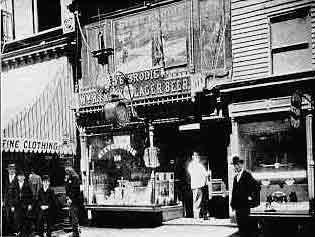
Literature
- The Bowery is the setting for Stephen Crane's first novel, Maggie: A Girl of the Streets (published in 1893), about a poor family living in the neighborhood.
- New York School poet Ted Berrigan mentions the Bowery several times in his seminal work "The Sonnets."
- Jack Kirby and Stan Lee's Fantastic Four #4 (1962), the Human Torch flees to the Bowery to lose himself "among all the other human derelicts..." In one of the Bowery's flophouses, he discovers the amnesiac 1940s-era character Namor the Sub-Mariner.
- The Wild Cards series of books sets the Bowery as Jokertown, the place where the malformed go to live after the Wild Card Virus is released over New York.
- Brenda Coultas' 2003 book of poetry, A Handmade Museum, contains a section called "the Bowery Project" which documents the pre-gentrification process.
Music
- Over the years, the Bowery has been mentioned in the lyrics of a number of songs, including the Bob Dylan song "Bob Dylan's 115th Dream", from the album Bringing It All Back Home (1965): "I walked by a Guernsey cow / Who directed me down / To the Bowery slums / Where people carried signs around / Saying, 'Ban the bums.'"
- Exuma, Bahamian folk singer and then resident of New York City has a song called "The Bowery" in his 1971 album Doo Wah Nanny. It describes the place as a "skid row".
- Rock band Bowery Electric's name was originated by Lawrence Chandler while residing in the area.
Stage
- The phrase "On the Bowery", which has since fallen into disuse, was a generic way to say one was down-and-out. It originated in the song "The Bowery" from the 1891 musical A Trip to Chinatown, which included the chorus "The Bow'ry, The Bow'ry!/They say such things,/and they do strange things/on the Bow'ry".
- On the Bowery, an 1894 play starring Steve Brodie, supposed Brooklyn Bridge jumper and Bowery saloonkeeper.
- In Disney's Newsies, the showgirls featured in the song "I Never Planned on You/Don't Come a-Knocking" are called the Bowery Beauties.
Film and television
- The 1925 film Little Annie Rooney takes place in the Bowery.
- The Bowery, a 1933 film about Brodie starring George Raft.
- The Bowery is portrayed in the 1934 Krazy Kat cartoon Bowery Daze.
- A popular B-movie series made between 1946 and 1958 featured "The Bowery Boys", led by Slip (Leo Gorcey) and Satch (Huntz Hall).
- The 1949 cartoon "Bowery Bugs" tells a fictionalized version of the Steve Brodie story, with Bugs Bunny as Brody's tormenter.
- On the Bowery, Lionel Rogosin's 1956 film, was nominated for the Academy Award for Best Documentary.
- In the 2002 film Gangs of New York, Bowery is a mentioned territory of the Bowery Boys, a street gang of the late 19th century during the New York Draft Riots.
- A crime lord known as the Bowery King, portrayed by Laurence Fishburne, is a major character in the John Wick franchise.
Art
- The Bowery in Two Inadequate Descriptive Systems, a collection of photographs and poems by Martha Rosler.
Advertising
- In the 1960s, radio and television commercials for the Bowery Savings Bank featured a jingle with the lyrics "The Bowery, The Bowery / The Bowery pays a lot / The Bowery pays you 6% / Commercial banks in New York simply do not." The number changed according to the amount of interest available on a passbook savings account offered by the bank.
Wrestling
- Professional wrestler Raven is kayfabe billed as being from the Bowery. The professional wrestler Scott Levy however was born in Philadelphia and lives in Atlanta.
See also
 In Spanish: Bowery para niños
In Spanish: Bowery para niños


